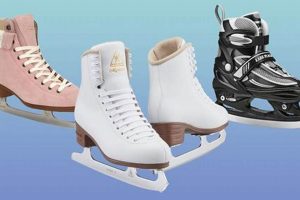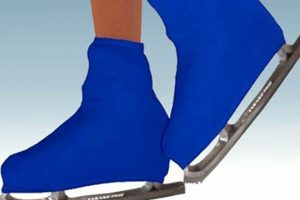The defining characteristic of bladed footwear used on ice surfaces is the honed edge. These edges, precisely ground, are the critical element allowing skaters to glide and maneuver effectively. Without this carefully created feature, movement across the ice would be extremely difficult, rendering complex skating maneuvers impossible. Imagine, for example, attempting to execute a figure skating jump or a hockey stop using dull blades; the lack of grip would result in a loss of control and likely a fall.
This meticulous edge preparation provides stability, control, and the ability to generate propulsion. The development of the modern blade edge represents a significant advancement in winter sports technology. Early iterations were rudimentary, offering limited performance compared to today’s precision-engineered equipment. The enhanced control afforded by correctly sharpened blades not only improves performance but also enhances safety by reducing the risk of uncontrolled slides and collisions.
Therefore, understanding the principles of edge geometry, the process of sharpening, and the maintenance required to preserve the integrity of the blades becomes essential for skaters of all levels. The following sections will delve into the specifics of blade edges, the sharpening process, and best practices for maintaining a high level of performance and safety on the ice.
Maintaining Optimal Blade Performance
Ensuring consistently high performance from bladed ice footwear necessitates diligent maintenance. The following guidelines outline critical steps to prolong blade life and maintain the necessary edge for safe and effective skating.
Tip 1: Consistent Edge Monitoring: Regular inspection of the blade’s edge is paramount. Look for nicks, burrs, or dull spots. Early detection of these imperfections allows for timely intervention, preventing further degradation and ensuring consistent performance.
Tip 2: Proper Drying Techniques: After each use, thoroughly dry the blades with a soft, absorbent cloth. Moisture accelerates corrosion, which can significantly reduce blade sharpness and longevity. Pay particular attention to the area where the blade meets the boot.
Tip 3: Edge Protection During Storage and Transport: Utilize blade guards at all times when the blades are not in contact with ice. These guards shield the delicate edges from impacts and abrasion, preventing damage during storage and transport.
Tip 4: Professional Sharpening Expertise: While some skaters attempt self-sharpening, entrusting the task to a qualified professional is highly recommended. Professionals possess the necessary equipment and expertise to achieve precise edge geometry and prevent over-grinding.
Tip 5: Frequency of Sharpening: The optimal sharpening frequency varies based on usage intensity and ice conditions. However, a general guideline is to sharpen after approximately 20-40 hours of skating. Listen to the feedback from the blades and adjust accordingly.
Tip 6: Avoid Walking on Unprotected Blades: Walking on any surface other than ice without blade guards is strictly discouraged. Even short distances can cause significant damage to the edges, rendering them dull and ineffective.
Tip 7: Use appropriate sharpening for different ice surface: The hardness and temperature of ice can dictate the need for a different sharpening methods. Using an experienced professional can help with achieving the proper blade edge.
Adhering to these maintenance procedures preserves the integrity of the blades, ensuring consistent performance, enhancing safety, and extending the lifespan of the equipment. These practices contribute to a more enjoyable and secure skating experience.
By prioritizing blade care and seeking professional assistance when needed, skaters can maximize the benefits of their equipment and maintain a competitive edge on the ice.
1. Precision Edge
The concept of a precision edge is fundamentally linked to the effectiveness of bladed ice footwear. The sharpness and quality of this edge directly dictate a skater’s ability to perform maneuvers, maintain balance, and achieve optimal speed on the ice surface. Its significance cannot be overstated.
- Blade Geometry and Ice Interaction
The geometry of the blade edge determines how it interacts with the ice. A precision edge is characterized by a fine, consistent angle that allows the blade to penetrate the ice cleanly. This controlled penetration enables the skater to “bite” into the ice, providing the necessary grip for propulsion and directional control. Without this precision, the blade would slip, reducing efficiency and increasing the risk of falls. For example, a figure skater executing a jump relies on the precision edge to maintain control during takeoff and landing.
- Sharpening Techniques and Edge Quality
Achieving a precision edge necessitates specific sharpening techniques. The use of specialized grinding equipment and expertise is required to create the desired angle and smoothness. Improper sharpening can result in a rounded or uneven edge, compromising performance. A hockey player, for instance, depends on a precisely sharpened edge for quick turns and stops during gameplay. A dull edge hinders these actions, impacting the player’s agility and reaction time.
- Material Composition and Edge Retention
The material composition of the blade plays a role in edge retention. High-carbon steel alloys are commonly used due to their ability to hold a sharp edge for an extended period. Softer metals will dull more rapidly, requiring more frequent sharpening. The material’s hardness, measured using methods like the Rockwell scale, directly influences how well it maintains its precision edge over time. Competitive skaters often choose blades made from specific alloys to optimize edge retention for peak performance.
- Impact on Maneuverability and Control
The precision edge directly influences the skater’s ability to execute complex maneuvers. Whether performing intricate figures, executing sharp turns, or maintaining balance on one foot, the edge provides the necessary grip and control. Skaters can manipulate the ice to generate force and direction. The degree of precision determines the level of control they possess. For example, freestyle skaters utilize the edge to perform spins and jumps, while speed skaters rely on it for maintaining a straight line at high velocities.
In conclusion, the precision edge represents a crucial attribute of bladed ice footwear. It is intricately linked to a skater’s performance, safety, and overall enjoyment of the sport. From blade geometry to sharpening techniques, a multitude of factors contribute to achieving and maintaining the highest standard of edge quality, underscoring its undeniable importance.
2. Glide Efficiency
Glide efficiency, the measure of how smoothly and effortlessly a blade moves across an ice surface, is inextricably linked to the condition of the bladed ice footwear. The state of the edge directly determines the amount of friction generated between the blade and the ice, thereby influencing skating speed, endurance, and overall performance.
- Edge Sharpness and Friction Reduction
A properly sharpened blade possesses a fine, clean edge that minimizes friction as it traverses the ice. This reduced friction allows for a smoother glide, requiring less effort from the skater to maintain momentum. Conversely, a dull edge increases friction, demanding greater exertion and reducing glide efficiency. For example, a speed skater with meticulously sharpened blades will experience significantly less resistance compared to one with poorly maintained edges, resulting in faster times and reduced fatigue.
- Blade Profile and Surface Contact
The profile, or curvature, of the blade affects the amount of surface area in contact with the ice. A well-designed blade profile distributes weight evenly along the edge, promoting consistent pressure and minimizing localized friction. A poorly shaped profile, resulting from improper sharpening or wear, can create uneven pressure points, leading to increased friction and diminished glide efficiency. Figure skaters benefit from a specific blade profile that facilitates both gliding and intricate maneuvers.
- Ice Temperature and Blade Condition
Ice temperature influences the amount of friction generated. Warmer ice tends to be softer and more “sticky,” increasing friction. In such conditions, a sharper edge is even more critical for maintaining glide efficiency. Colder ice, being harder, allows for better glide, but a sharp edge is still necessary for control and maneuverability. The interaction between ice temperature and blade condition underscores the importance of adapting sharpening practices to environmental conditions. For instance, hockey players competing on freshly resurfaced, colder ice may prefer a different sharpening profile compared to practicing on warmer, softer ice.
- Blade Material and Ice Interaction
Different blade materials interact differently with the ice surface, affecting the friction coefficient. High-carbon steel and stainless steel are common choices, each possessing unique properties. The choice of material, in conjunction with proper sharpening, directly impacts glide efficiency. A skater might opt for a specific steel composition based on personal preference and the type of skating they perform, aiming to optimize glide characteristics.
In summary, glide efficiency is directly governed by the state of the bladed ice footwear. Maintaining the blade with an optimal sharp edge and appropriate profile is critical for minimizing friction, conserving energy, and maximizing performance across a range of skating disciplines and ice conditions. The interplay between edge sharpness, blade profile, ice temperature, and blade material collectively determines the skater’s ability to glide efficiently and effectively.
3. Maneuverability
The capacity for precise and controlled movement on ice, termed maneuverability, is fundamentally linked to the sharpness of bladed ice footwear. The edges enable skaters to initiate turns, stops, and directional changes. A dull blade diminishes this capability, resulting in reduced control and an inability to execute intricate maneuvers effectively. The direct correlation lies in the blade’s ability to “bite” into the ice; a sharp edge allows for a clean, controlled cut, while a dull edge slips and slides, compromising the skater’s ability to dictate their trajectory. The importance of maneuverability, therefore, is paramount; it is not merely a convenience but a critical element for performance and safety. In hockey, for instance, a player’s ability to quickly change direction can be the difference between scoring a goal and losing possession. Similarly, figure skaters rely on sharp edges to perform jumps, spins, and complex footwork with precision.
The effectiveness of the edge is further influenced by the skater’s weight distribution and technique. Even with optimally sharpened blades, improper weight placement can lead to instability and reduced maneuverability. Skaters must learn to engage the edges correctly, applying pressure and controlling their center of gravity to execute maneuvers efficiently. Training programs and coaching often emphasize the development of edge control skills to maximize the benefits of sharp blades. The practical application of this understanding extends to equipment selection; the choice of blade profile and rocker (the curvature of the blade along its length) can further enhance maneuverability, depending on the skater’s style and discipline.
In conclusion, maneuverability hinges on the condition of the blades. While technique and weight distribution play a role, the sharpness of the edge is the foundation upon which controlled movement is built. Challenges associated with maintaining optimal sharpness include wear and tear, improper sharpening, and varying ice conditions. Recognizing the fundamental relationship between edge sharpness and maneuverability is essential for skaters of all levels, informing equipment maintenance practices, training strategies, and ultimately, performance on the ice.
4. Edge Angle
The edge angle represents a critical geometric parameter of bladed ice footwear. It directly influences the interaction between the blade and the ice surface, thereby significantly affecting performance characteristics. The creation and maintenance of a precise edge angle is a direct determinant of whether the footwear is sharp and effective for intended use. A properly formed angle allows the skater to engage the ice with minimal slippage, enabling controlled movement and efficient energy transfer. In contrast, an improperly formed or dulled edge angle compromises grip, leading to reduced maneuverability and increased risk of falls. For instance, the edge angle on figure skating blades, typically sharper than those used in hockey, facilitates the precise turns and intricate footwork required in that discipline.
The achievement of an optimal edge angle involves specialized sharpening techniques and equipment. Grinding wheels with specific profiles and grits are employed to create the desired bevel on the blade. Experienced technicians understand that the ideal angle varies based on the skater’s skill level, weight, and skating style. Furthermore, the type of ice encountered (e.g., hard, soft, cold, warm) can influence the preferred edge angle. Regular maintenance, including honing and occasional professional sharpening, is essential for preserving the integrity of the angle. Failure to maintain the correct angle results in a gradual degradation of sharpness, ultimately impacting performance and safety. For example, a hockey player with a rounded edge angle may struggle to execute quick stops and turns, hindering their ability to compete effectively.
In conclusion, the edge angle is an indispensable component of sharp bladed ice footwear. Its precise formation and consistent maintenance are paramount for optimizing performance, ensuring safety, and maximizing the skater’s control on the ice. Understanding the relationship between edge angle and sharpness empowers skaters to make informed decisions regarding blade maintenance, ultimately enhancing their overall skating experience. Challenges in achieving and preserving the optimal angle highlight the need for specialized expertise and diligent attention to detail, underscoring the practical significance of this fundamental aspect of bladed ice footwear.
5. Steel Hardness
The efficacy of bladed ice footwear is intrinsically linked to the hardness of the steel used in its construction. Steel hardness, measured using scales such as Rockwell or Vickers, directly influences the blade’s ability to achieve and retain a sharp edge. Softer steels, while easier to sharpen, are prone to rapid dulling and deformation under the stresses of skating. Conversely, excessively hard steels, while resistant to wear, can be brittle and prone to chipping or cracking, particularly upon impact. The selection of an appropriate steel hardness is, therefore, a crucial compromise between edge retention and structural integrity. High-carbon steels, often heat-treated to achieve a specific hardness range, are commonly employed to optimize these conflicting requirements. The relationship between steel hardness and blade sharpness dictates the frequency of sharpening required and, consequently, the overall maintenance demands of the equipment. Without sufficient hardness, even meticulous sharpening techniques will be rendered ineffective due to rapid edge degradation.
The practical implications of steel hardness extend to various skating disciplines. For example, figure skaters, who demand precise edge control for intricate footwork and jumps, often prefer blades with a higher hardness rating to maintain a sharp edge for extended periods. Hockey players, who subject their blades to frequent impacts and abrasive ice conditions, might opt for a slightly softer steel that is less prone to chipping, albeit requiring more frequent sharpening. Furthermore, the manufacturing process plays a critical role in achieving the desired steel hardness and uniformity. Properly controlled heat treatment processes are essential for ensuring consistent hardness throughout the blade, preventing localized weak spots that could compromise performance and safety. The specific alloy composition of the steel, including the presence of elements such as chromium, molybdenum, or vanadium, also contributes to its hardness and wear resistance.
In conclusion, steel hardness is a fundamental material property that governs the effectiveness of bladed ice footwear. The optimal hardness range balances the need for edge retention with resistance to wear and fracture. Understanding the relationship between steel hardness and blade sharpness allows skaters to make informed equipment choices and maintenance decisions. Challenges associated with achieving and maintaining the desired steel hardness underscore the importance of selecting high-quality materials and employing precise manufacturing techniques. The steel hardness influences blade sharpness thus has considerable impact on skater performance, safety and experience.
6. Maintenance
The degree to which bladed ice footwear retains its sharpness is intrinsically linked to consistent and proper maintenance. The execution of diligent maintenance protocols directly impacts blade longevity, performance consistency, and overall skater safety. Neglecting maintenance leads to a rapid degradation of the edge, compromising the effectiveness of the blades and diminishing the skating experience.
- Regular Cleaning and Drying
Corrosion is a significant factor in edge degradation. Moisture left on the blades after use accelerates rust formation, which dulls the edge and weakens the steel. Consistent cleaning with a dry, absorbent cloth immediately following each skating session removes residual moisture and prevents rust from forming. This simple practice significantly extends the lifespan of the blades and preserves their sharpness. For example, failing to dry the blades after skating in a humid environment will lead to visible rust within a short period, necessitating more frequent sharpening or even blade replacement.
- Protective Storage and Transportation
The edges are vulnerable to damage from impacts and abrasion when the blades are not in use. Storing and transporting the blades without proper protection, such as blade guards made of soft materials, can result in nicks, burrs, and dull spots. Blade guards act as a barrier, shielding the delicate edges from contact with hard surfaces. Utilizing guards ensures that the blades retain their sharpness between uses. Consider the scenario where blades are stored unprotected in a skate bag; the rubbing against other equipment can cause significant edge damage.
- Professional Sharpening and Honing
While regular cleaning and protection help maintain sharpness, periodic professional sharpening is essential for restoring the edge to its optimal geometry. Sharpening involves grinding the blade to create a precise angle and remove any imperfections. Honing, a less aggressive process, refines the edge between sharpenings. The frequency of sharpening depends on usage intensity and ice conditions. Engaging a qualified technician ensures that the blades are sharpened correctly, preventing over-grinding and maintaining the integrity of the steel. A poorly sharpened blade can be more detrimental than a dull blade, potentially altering the intended edge characteristics and impacting performance.
- Edge Inspection and Addressing Imperfections
Regular visual inspection of the edges allows for the early detection of nicks, burrs, or dull spots. Promptly addressing these imperfections prevents them from worsening and compromising the overall edge quality. Minor burrs can often be removed with a honing stone, while more significant damage may require professional sharpening. Early intervention minimizes the need for aggressive sharpening, prolonging the life of the blades. A skater who regularly inspects their blades can identify and address minor issues before they escalate, maintaining consistent sharpness and performance.
Effective maintenance practices are pivotal for preserving the sharpness of bladed ice footwear. Consistent cleaning, protective storage, professional sharpening, and regular inspections collectively ensure that the blades remain in optimal condition. By adhering to these maintenance protocols, skaters can maximize blade performance, enhance safety, and extend the lifespan of their equipment. Neglecting maintenance leads to rapid edge degradation, compromising the very characteristic that defines the functionality of the blades.
Frequently Asked Questions
This section addresses common inquiries regarding the sharpness of bladed ice footwear, providing clarity on related aspects.
Question 1: Why is sharpness crucial for bladed ice footwear?
Sharpness allows for effective engagement with the ice, enabling controlled movement, efficient gliding, and precise maneuvers. A dull blade compromises these capabilities, increasing the risk of falls and hindering performance.
Question 2: How does steel hardness influence blade sharpness?
Steel hardness dictates the blade’s ability to attain and retain a sharp edge. An appropriate hardness level balances edge retention with resistance to wear and fracture. Softer steels dull more rapidly, while excessively hard steels can be brittle.
Question 3: How often should bladed ice footwear be sharpened?
Sharpening frequency varies based on usage intensity, ice conditions, and steel hardness. Regular inspection for dullness or imperfections is recommended to determine the need for sharpening. Professional sharpening is advised to maintain optimal edge geometry.
Question 4: Can one sharpen bladed ice footwear independently, or is professional assistance required?
While independent sharpening is possible, professional assistance is generally recommended. Professionals possess specialized equipment and expertise to achieve precise edge angles without damaging the blades. Improper sharpening can be more detrimental than dullness.
Question 5: What maintenance practices preserve blade sharpness?
Consistent maintenance includes regular cleaning and drying after each use to prevent corrosion, protective storage with blade guards, and periodic professional sharpening and honing. Edge inspection allows for early detection and correction of imperfections.
Question 6: How does blade profile affect sharpness and performance?
Blade profile, or curvature, influences the contact area with the ice. A well-designed profile distributes weight evenly, minimizing friction and promoting consistent pressure. A poorly shaped profile can compromise glide efficiency and maneuverability.
Maintaining sharpness in bladed ice footwear is essential for safety, performance, and an enjoyable skating experience. Addressing these frequently asked questions helps clarify the complexities of blade sharpness and its impact.
The subsequent sections will discuss common blade-related issues and troubleshooting techniques.
Conclusion
The preceding analysis establishes unequivocally that the sharpness of bladed ice footwear is not merely a desirable attribute, but a fundamental requirement for safe and effective performance. Exploration has encompassed the critical role of steel hardness, precise edge angles, and consistent maintenance practices, each contributing significantly to the overall functionality of the equipment. The interdependence of these factors dictates the skater’s ability to control movement, generate speed, and execute maneuvers with confidence. Deviation from optimal sharpness parameters results in compromised performance and heightened risk of injury.
Given the demonstrated importance of maintaining blade sharpness, skaters of all levels are urged to prioritize regular inspection, diligent maintenance, and professional sharpening services. Investing in the proper care of bladed ice footwear translates directly into enhanced safety, improved performance, and a more rewarding skating experience. Recognition of the relationship between edge quality and performance is essential for responsible participation in ice-based activities.







